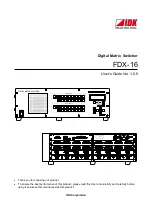
TRSM Description
3
nonvolatile RAM so they will survive a power loss or system initialization.
Source Routed traffic is not forwarded while in this mode.
Source Routing (SR)
In Source Routing (SR), the packet contains information in the Route
Information Field (RIF), which specifies the route the packet should follow in
order to reach its destination. Through the process of route discovery, the
packet determines various routes available and embeds this information as
Ring Numbers and Bridge Numbers within the RIF. The bridge compares the
RIF to its configured Bridge Numbers and Ring Numbers for each port and
forwards the packet if appropriate. The TRSM utilizes one hop between any
two ports on the module.
For Spanning Tree, the network mesh topology is reduced to a single path
utilizing IEEE 802.1d Spanning Tree.
Transparent traffic is not forwarded while in this mode.
Source Routing Transparent (SRT)
The Source Routing-Transparent (SRT) operation complies with the 802.1d
standard which provides bridging for both Source Routing and non-Source
Routing protocols. It uses the Route Information Indicator to differentiate
between SR and non-SR packets and applies the appropriate bridging
method on each packet received.
To configure the Bridging mode, see Chapter 11:
Administering the Bridge
in
the
LANplex 6000 Administration Console User Guide
.
N
TRSM Configurable
Protocol Translation
Modes
Protocol addresses on Token Ring are defined in non-canonical format while
FDDI is defined in canonical format. For a workstation on Token Ring to
communicate with a server on FDDI, it is necessary to reformat or translate
these embedded protocol address. The TRSM supports translation between
Token Ring and FDDI for the following protocols: IP, IPX, NetBIOS, and SNA.
Translation is not necessary if FDDI is only used as a transport media
between TRSMs. Since this feature may degrade performance, it is
recommended that you disable the translation feature when FDDI is used
solely as a transport media.


































